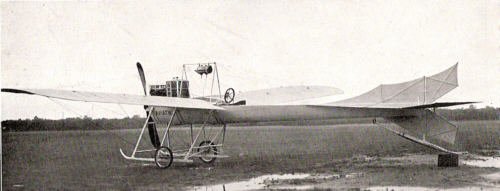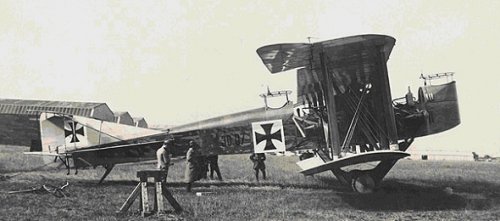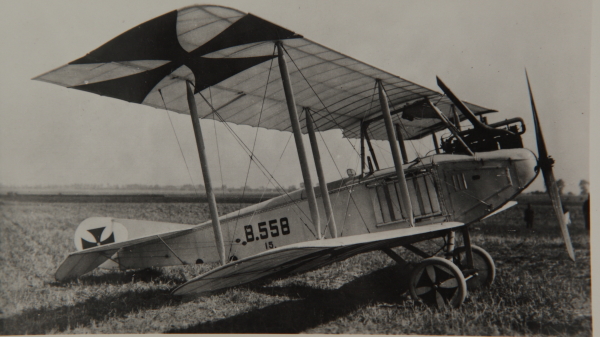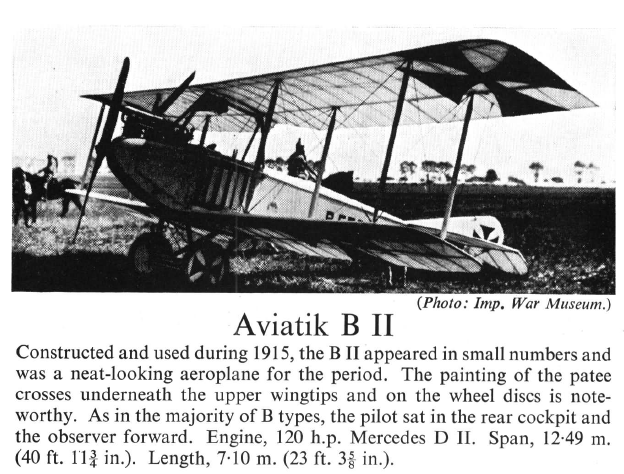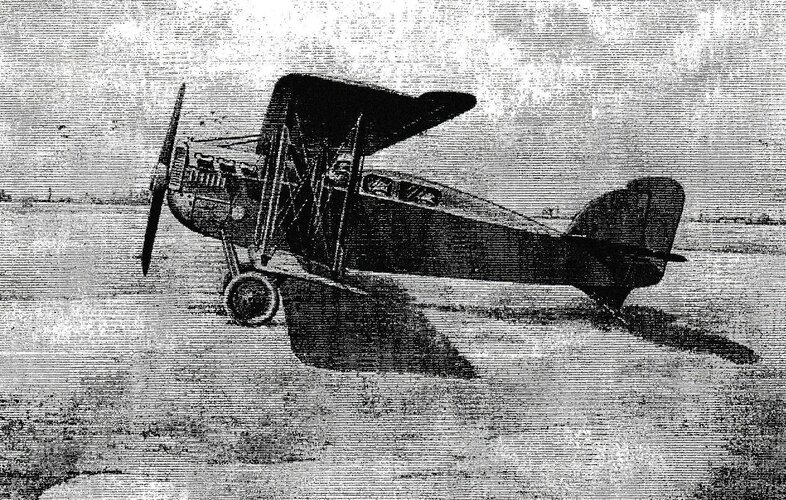- Joined
- 28 January 2008
- Messages
- 635
- Reaction score
- 512
Automobil und Aviatik AG was a German aircraft manufacturer during World War I. The company was established at Mülhausen (today in France) in 1910 by Julius Spengler and soon became one of the country's leading producers of aircraft, relocating to Freiburg in 1914 and establishing a subsidiary in Vienna as Österreichisch-Ungarische Flugzeugfabrik Aviatik. Due to the French border being very close, the firm relocated to Leipzig when hostilities started in 1914.
During the war, the company became best known for its reconnaissance aircraft, the B.I and B.II, although the Austro-Hungarian subsidiary also produced a number of its own designs, including fighters such as the D.I.
The company at first started with the license-production of French aircraft; Hanriot, and Farman, and from 1912, started building their own designs. The company was closed down 1920.
A quick note on the B and B.I/II designations. Up to 1915 Aviatik used their own designations (B/P12 etc which were often recorded later as B/12). When Idflieg set definitive naming protocols these B/P12 to B/20 types were share out among the B.I and B.II designations. Some B/P15 were designated B.I others B.II.
Aviatik Aircraft Types
Aviatik Monoplane (1913)
Single engine tractor monoplane loosely based on Taube layout. Straight wings with four wheeled landing gear, in pairs.
Aviatik B (1912)
Biplane used for training, widely known as the P13 within the Aviatik organisation. Single engine wood and fabric aeroplane with 4 bay wings. Built fitted with Argus As.0, Argus As.1 or Mercedes D.I engines. Radiator located on starboard side, just behind the engine. Pilot seated in rear, student forward.
Variants:
B/P12 - one built. Fitted with wheeled landing gear with skids to prevent nosing over.
B/P13 - over 80 completed from 1914 to last delivery in June 1916.
B/P14 - smaller than the P13 fitted with Argus, Mercedes or Benz engines. Saw service with the Swiss Air Service in 1915.
B/P15 - refined P13 with two-bay wings and a fixed fin. Powered by Argus As.1 or Mercedes D.I (both 100 hp). Some built with three bay wings and utilised as bombers. Some saw service with Turkey.
B/P15a - mentioned in Idflieg documentation in 1915 but no other information found yet apart from reference of German Wikipedia that states these may have been designated as B.I's with Mercedes D.I engines.
B/P15b - mentioned in Idflieg documentation but no other information found yet apart from reference of German Wikipedia that states these may have been designated as B.II's with Mercedes D.II engines.
Aviatik B.I (1914)
A two-seat reconnaissance biplane which was developed from a 1913 design for a racing aircraft. The crew sat in open tandem cockpits with the observer in the front. It entered service in 1914.The B.I was manufactured in large numbers in Italy under licence by Società Aeronautica Meccanica Lombardia (SAML). Engine was Mercedes D.I 6-cylinder liquid-cooled inline engine, 74.5 kW (99.9 hp) Over 250 completed.
Aviatik B.II (1915)
A reconnaissance aircraft built in Germany and Austria-Hungary during World War I. It was a two-seat biplane of conventional configuration that seated its pilot and observer in tandem, open cockpits. Compared to its predecessor, the B.I, the B.II had a more powerful 1 × Mercedes D.II, 88 kW (120 hp) engine and revised nose design that faired the powerplant. Austro-Hungarian built D.IIs featured revised, enlarged ailerons, and Austro-Daimler engines.
Variants:
P.20 - Biplane it was fitted with a 100 hp Oberursel rotary. Prototype used by Schwabe & Co as the base for around ten training aircraft which were fitted with 100 hp Schwabe Stahlherz rotary engines.
Aviatik B.III (1916)
Reconnaissance aircraft built in Austria-Hungary during World War I. Aviatik's Austro-Hungarian subsidiary had built the German-designed B.II, and now further developed this design by adding a more powerful Austro-Daimler inline, 120 kW (160 hp)
engine and armament in the form of a defensive machine gun and bomb racks. It was otherwise similar to Austro-Hungarian built B.IIs, incorporating enhancements made locally to the original design. All were obsolete and out of service by the end of 1916.
Aviatik C.I (1915)
The Aviatik C.I was a observation aircraft . It was the successor to the Aviatik B.I and B.II models. In the C.I the observer sat in front of the pilot, with two machine-guns, mounted on rails on each side of the observer's cockpit. Engine was either a Benz Bz.III (150 hp) or Mercedes D.III (160 hp).
Variants:
C.Ia (1916) - The positions of the pilot and observer were reversed in the C.Ia version of the observation aircraft. Ordered in April 1916, the first 25 were delivered in May and June that year. One of these became the prototype C.III (serial 1750/16). Mercedes D.III engine fitted.
Aviatik C.II (1916)
Development of the C.I with more power and load capabilities. It had reduced drag and wing area. This model was powered by a 149 kW (200 hp) Benz Bz. IV engine. Over 75 completed.
Aviatik C.III (1916)
An observation aircraft based on the C.I with more powerful 160 hp Mercedes D.III engine to improve speed. The C.III was produced in large numbers (@250) and was introduced into service before the C.II. Saw service into 1917.
Aviatik C.IV (1917)
An observation aircraft which was possibly reserved for the license built DFW C.V type.
Aviatik C.V (1917)
An observation prototype. Only one completed, with a Argus As.III (180 hp) engine, in 1917. Distinctive upper gull wing.
Aviatik C.VI (1917)
An observation biplane which was reserved for the license built DFW C.V type.
Aviatik C.VII (1917)
A project for an unbuilt reconnaissance and observation biplane.
Aviatik C.VIII (1917)
A reconnaissance and observation two-seat biplane. It had a single bay and for aerodynamic reasons the lower wing was attached to a keel beneath the fuselage. This necessitated additional small struts. It was in the C competition against the Halberstadt CL.II and Hannover CL.II. Powered by a Mercedes D.III 160 hp motor.
Aviatik C.IX (1918)
A reconnaissance and observation two-seat biplane. Three prototypes were built with nose radiators to cool the Benz Bz.IV (200 hp) engine. All three examples featured different tail arrangements in an effort to discover the best qualities of the type. The lower wing suspended on struts producing a gap between the wing and fuselage. Fitted with duns for both the pilot and observer.
Aviatik D.I (1916)
Aviatik of Leipzig-Heiterblick licence-built the Halberstadt D.II as the Aviatik D.I - later known as the Halberstadt D.II(Av)in late 1916. The experience helped in developing and building first original Aviatik single-seat fighter design, designated as the D.II .
Aviatik D.II (1916)
Developed from experiences learned with the D.I, the D.II was an orthodox staggered single-bay biplane with wood and fabric-covered wings. The airframe construction featured a steel tube forward section covered in a metal skin. The aft fuselage was largely skinned in plywood. Power was generated by the 160hp Mercedes D.III six-cylinder water-cooled engine. The armament consisted of the standard twin synchronized machine guns firing through the air-screw disc. It had poor performance and only the prototype was completed.
Aviatik D.III (1917)
This was a German prototype single-seat fighter plane and it became the basis for the Aviatik D.IV and Aviatik D.V. In November 1917, the plane was first flown, using a Benz Bz IIIbo 8-cylinder liquid-cooled V engine, 145 kW (195 hp) gearless engine. It was of similar design to the Aviatik D.II, and was armed with two machine guns. The with lower wing mounted to a keel and faired to the fuselage. Two completed. The second example had a geared Benz Bz.IIIbm V-8 engine fitted which produced 195 hp of power.
Aviatik D.IV (1918)
Fighter developed from the D.III powered by the geared Benz Bz.IIIbv V-8 motor.
Aviatik D.V (1918)
Fighter powered by the geared Benz Bz.IIIbv V-8 motor and a wholly new design for a single-bay fighter.
Aviatik D.VI (1918)
Biplane fighter powered by a geared Benz Bz IIIbm liquid cooled V-8 200hp (149 kW) engine driving a four-bladed propeller. This engine had reliability issues. Armament comprised the standard twin synchronised machine guns. First flew in August 1918 and only a prototype completed as it was superseded by the D.VII.
Aviatik D.VII (1918)
The D.VII, which was intended to participate in the third Fighter D-type Contest of October 1918, was essentially similar to the D.VI apart from having completely redesigned vertical and horizontal tail surfaces. Like its predecessor it was powered by a geared Benz Bz IIIbm liquid cooled V-8 cylinder engine 200hp (149 kW) engine driving a four-bladed propeller. Armament comprised the standard twin synchronised machine guns, and only one prototype was officially completed although fifty aircraft were found by the allied commission post-armistice. The type was proposed as a sportplane 1919.
Aviatik F.I (1918)
Long range reconnaissance three-bay biplane. One Benz Bz.V (300 hp) V12 motor powered this large aircraft which had a range of over 500 km. The armistice intervened in its development and it saw post-war service.
Variants:
F Limousine (1918) - Converted F.I prototype to become a civilian transport for two passengers and mail. Side windows fitted for the enclosed passenger cabin behind the pilot. Built but questionable if it ever flew.
Aviatik R.I (1917)
The initial order was for three Staaken R.VI machines, the first of which was delivered in September 1917. Unofficially this series was known as the Aviatik R.I within the company.
Aviatik R.II (1917)
The first series was followed by a second batch of three Staaken R.VI machines. These aircraft (known internally as Aviatik R.II) were modified to some extent by Aviatik, and in at least one instance the stepped, glassed-in cockpit was eliminated and replaced by a front-gun position and open cockpit. The first aircraft was initially powered by four Basse & Selve BuS.IVa (300 hp) engines. These engines were problematic during tests in May 1918 and were replaced by the more reliable, less powerful, Maybach Mb.IVa (245 hp) engines. The completion of the last Aviatik-built Staaken R.VI was delayed until October 1918 pending a decision whether or not to install a fifth Maybach in the nose.
Aviatik R.III (1918)
The final series of three built by Aviatik under licence was the Staaken R.XVI known internally as Aviatik R.III of which only one was delivered befor the armistice.
Variants:
R.III Civil Transport (1919) - In early 1919 Aviatik had the two part-completed R.XVI and they received permission to complete these as commercial transports, but only the first was finished. Aviatik publicized the Aviatik R.III Civil Transport andhe R.III received full coverage in the aeronautical press, including Flight in the UK. However, the civil adaptation did not advance farther than the design stage. The fuselage was redesigned to accommodate eighteen passengers in seats placed back-to-back. A small open cupola was situated in the nose, followed by an enclosed observation cabin. The crew consisted of an aircraft captain, two pilots, two engineers and a steward. The four tandem, geared Benz (250 hp) engines were mounted on streamlined pylons above the lower wing.
Built by other organisations:
Aviatik (Han) C.I (1915)
License built with first completed examplein February 1916. Fliegertruppe received 164 of this type.
Aviatik (Ö) C.I (1917)
The Aviatik (Ö) C.I, the prototypes of which were known as Aviatik 30.14, Aviatik 30.15 and Aviatik 30.16, was an Austro-Hungarian 2-seat reconnaissance aircraft produced from 1917. Some C.I aircraft were converted to single-seaters.
Aviatik (Berg) D.I (1917)
The Aviatik (Berg) D.I, was a single-engine, single-seater fighter biplane. It was also known as Berg D.I or the Berg Fighter because it was designed by Dipl. Ing. Julius von Berg, and to distinguish it from the D.I fighter built by the parent Aviatik firm in Germany. The D.I was the first locally designed fighter aircraft of the Austro-Hungarian Air Service. The Aviatik (Berg) D.I was manufactured under license by a number of subcontractors.
Aviatik (Berg) D.II (1918)
This was a version of the D.I with a cantilever lower wing. The model went into production in late 1918 in two Series (39 and 339), but the production aircraft were too late for operational service.
Aviatik (Berg) D.III (1918)
A high-altitude version with a 230 hp Hiero engine and the Dr.I triplane development remained as prototypes only.
AEG-Aviatik R-plane Project (1917)
Toward the end of 1917 Idflieg, greatly influenced by the large capacity of the Caproni triplanes, proposed the construction of multi-engined triplanes, the only completed example of which was the LVG G.III. However, AEG and Aviatik undertook a joint project to build, what would have been, the largest R-plane envisioned at that time. The partially completed aircraft was centrally powered and presented another solution of the engine arrangement problem; in this instance the engines were mounted side by side, and each drove a single propeller by means of an extended shaft leading through the middle wing to a right-angle bevel gear-box, which eliminated the usual bulky gear and clutch systems. This and the DFW power transmission were the simplest of the central-engine systems. Although eight 250 h.p. engines were initially proposed, the advent of the 530 hp 12 cylinder Benz Bz.VI engine permitted the use of only four engines to attain the required 2000 horse-power. These were to be supercharged by a 120 hp Mercedes D.II engine driving a centrifugal compressor. The fuselage was to be constructed of four massive wooden box longerons with steel-tube cross struts and engine bearers. The wing structure was heavily staggered, reminiscent of the experimental Nieuport triplanes and shown to be an efficient arrangement by the Gottingen wind-tunnel tests. The lower wing was attached to the fuselage by a streamlined extension containing the bombardier's cabin.
Sources:
http://www.histaviation.com/Automobil_and_Aviatik_AG.html
http://de.wikipedia.org/wiki/Aviatik_B-Typen
http://www.secretprojects.co.uk/forum/index.php/topic,10968.msg104305.html#msg104305
http://www.secretprojects.co.uk/forum/index.php/topic,17662.msg168329.html#msg168329
http://flyingmachines.ru/Site2/Crafts/Craft31359.htm
G W Haddow & Peter Grosz - The German Giants (Putnam)
Peter Gray & Owen Thetford - German Aircraft of The First World War (Putnam)
Jack Herris - Aviatik Aircraft of World War I (Aeronaut)
Flight Magazine September 11, 1919
During the war, the company became best known for its reconnaissance aircraft, the B.I and B.II, although the Austro-Hungarian subsidiary also produced a number of its own designs, including fighters such as the D.I.
The company at first started with the license-production of French aircraft; Hanriot, and Farman, and from 1912, started building their own designs. The company was closed down 1920.
A quick note on the B and B.I/II designations. Up to 1915 Aviatik used their own designations (B/P12 etc which were often recorded later as B/12). When Idflieg set definitive naming protocols these B/P12 to B/20 types were share out among the B.I and B.II designations. Some B/P15 were designated B.I others B.II.
Aviatik Aircraft Types
Aviatik Monoplane (1913)
Single engine tractor monoplane loosely based on Taube layout. Straight wings with four wheeled landing gear, in pairs.
Aviatik B (1912)
Biplane used for training, widely known as the P13 within the Aviatik organisation. Single engine wood and fabric aeroplane with 4 bay wings. Built fitted with Argus As.0, Argus As.1 or Mercedes D.I engines. Radiator located on starboard side, just behind the engine. Pilot seated in rear, student forward.
Variants:
B/P12 - one built. Fitted with wheeled landing gear with skids to prevent nosing over.
B/P13 - over 80 completed from 1914 to last delivery in June 1916.
B/P14 - smaller than the P13 fitted with Argus, Mercedes or Benz engines. Saw service with the Swiss Air Service in 1915.
B/P15 - refined P13 with two-bay wings and a fixed fin. Powered by Argus As.1 or Mercedes D.I (both 100 hp). Some built with three bay wings and utilised as bombers. Some saw service with Turkey.
B/P15a - mentioned in Idflieg documentation in 1915 but no other information found yet apart from reference of German Wikipedia that states these may have been designated as B.I's with Mercedes D.I engines.
B/P15b - mentioned in Idflieg documentation but no other information found yet apart from reference of German Wikipedia that states these may have been designated as B.II's with Mercedes D.II engines.
Aviatik B.I (1914)
A two-seat reconnaissance biplane which was developed from a 1913 design for a racing aircraft. The crew sat in open tandem cockpits with the observer in the front. It entered service in 1914.The B.I was manufactured in large numbers in Italy under licence by Società Aeronautica Meccanica Lombardia (SAML). Engine was Mercedes D.I 6-cylinder liquid-cooled inline engine, 74.5 kW (99.9 hp) Over 250 completed.
Aviatik B.II (1915)
A reconnaissance aircraft built in Germany and Austria-Hungary during World War I. It was a two-seat biplane of conventional configuration that seated its pilot and observer in tandem, open cockpits. Compared to its predecessor, the B.I, the B.II had a more powerful 1 × Mercedes D.II, 88 kW (120 hp) engine and revised nose design that faired the powerplant. Austro-Hungarian built D.IIs featured revised, enlarged ailerons, and Austro-Daimler engines.
Variants:
P.20 - Biplane it was fitted with a 100 hp Oberursel rotary. Prototype used by Schwabe & Co as the base for around ten training aircraft which were fitted with 100 hp Schwabe Stahlherz rotary engines.
Aviatik B.III (1916)
Reconnaissance aircraft built in Austria-Hungary during World War I. Aviatik's Austro-Hungarian subsidiary had built the German-designed B.II, and now further developed this design by adding a more powerful Austro-Daimler inline, 120 kW (160 hp)
engine and armament in the form of a defensive machine gun and bomb racks. It was otherwise similar to Austro-Hungarian built B.IIs, incorporating enhancements made locally to the original design. All were obsolete and out of service by the end of 1916.
Aviatik C.I (1915)
The Aviatik C.I was a observation aircraft . It was the successor to the Aviatik B.I and B.II models. In the C.I the observer sat in front of the pilot, with two machine-guns, mounted on rails on each side of the observer's cockpit. Engine was either a Benz Bz.III (150 hp) or Mercedes D.III (160 hp).
Variants:
C.Ia (1916) - The positions of the pilot and observer were reversed in the C.Ia version of the observation aircraft. Ordered in April 1916, the first 25 were delivered in May and June that year. One of these became the prototype C.III (serial 1750/16). Mercedes D.III engine fitted.
Aviatik C.II (1916)
Development of the C.I with more power and load capabilities. It had reduced drag and wing area. This model was powered by a 149 kW (200 hp) Benz Bz. IV engine. Over 75 completed.
Aviatik C.III (1916)
An observation aircraft based on the C.I with more powerful 160 hp Mercedes D.III engine to improve speed. The C.III was produced in large numbers (@250) and was introduced into service before the C.II. Saw service into 1917.
Aviatik C.IV (1917)
An observation aircraft which was possibly reserved for the license built DFW C.V type.
Aviatik C.V (1917)
An observation prototype. Only one completed, with a Argus As.III (180 hp) engine, in 1917. Distinctive upper gull wing.
Aviatik C.VI (1917)
An observation biplane which was reserved for the license built DFW C.V type.
Aviatik C.VII (1917)
A project for an unbuilt reconnaissance and observation biplane.
Aviatik C.VIII (1917)
A reconnaissance and observation two-seat biplane. It had a single bay and for aerodynamic reasons the lower wing was attached to a keel beneath the fuselage. This necessitated additional small struts. It was in the C competition against the Halberstadt CL.II and Hannover CL.II. Powered by a Mercedes D.III 160 hp motor.
Aviatik C.IX (1918)
A reconnaissance and observation two-seat biplane. Three prototypes were built with nose radiators to cool the Benz Bz.IV (200 hp) engine. All three examples featured different tail arrangements in an effort to discover the best qualities of the type. The lower wing suspended on struts producing a gap between the wing and fuselage. Fitted with duns for both the pilot and observer.
Aviatik D.I (1916)
Aviatik of Leipzig-Heiterblick licence-built the Halberstadt D.II as the Aviatik D.I - later known as the Halberstadt D.II(Av)in late 1916. The experience helped in developing and building first original Aviatik single-seat fighter design, designated as the D.II .
Aviatik D.II (1916)
Developed from experiences learned with the D.I, the D.II was an orthodox staggered single-bay biplane with wood and fabric-covered wings. The airframe construction featured a steel tube forward section covered in a metal skin. The aft fuselage was largely skinned in plywood. Power was generated by the 160hp Mercedes D.III six-cylinder water-cooled engine. The armament consisted of the standard twin synchronized machine guns firing through the air-screw disc. It had poor performance and only the prototype was completed.
Aviatik D.III (1917)
This was a German prototype single-seat fighter plane and it became the basis for the Aviatik D.IV and Aviatik D.V. In November 1917, the plane was first flown, using a Benz Bz IIIbo 8-cylinder liquid-cooled V engine, 145 kW (195 hp) gearless engine. It was of similar design to the Aviatik D.II, and was armed with two machine guns. The with lower wing mounted to a keel and faired to the fuselage. Two completed. The second example had a geared Benz Bz.IIIbm V-8 engine fitted which produced 195 hp of power.
Aviatik D.IV (1918)
Fighter developed from the D.III powered by the geared Benz Bz.IIIbv V-8 motor.
Aviatik D.V (1918)
Fighter powered by the geared Benz Bz.IIIbv V-8 motor and a wholly new design for a single-bay fighter.
Aviatik D.VI (1918)
Biplane fighter powered by a geared Benz Bz IIIbm liquid cooled V-8 200hp (149 kW) engine driving a four-bladed propeller. This engine had reliability issues. Armament comprised the standard twin synchronised machine guns. First flew in August 1918 and only a prototype completed as it was superseded by the D.VII.
Aviatik D.VII (1918)
The D.VII, which was intended to participate in the third Fighter D-type Contest of October 1918, was essentially similar to the D.VI apart from having completely redesigned vertical and horizontal tail surfaces. Like its predecessor it was powered by a geared Benz Bz IIIbm liquid cooled V-8 cylinder engine 200hp (149 kW) engine driving a four-bladed propeller. Armament comprised the standard twin synchronised machine guns, and only one prototype was officially completed although fifty aircraft were found by the allied commission post-armistice. The type was proposed as a sportplane 1919.
Aviatik F.I (1918)
Long range reconnaissance three-bay biplane. One Benz Bz.V (300 hp) V12 motor powered this large aircraft which had a range of over 500 km. The armistice intervened in its development and it saw post-war service.
Variants:
F Limousine (1918) - Converted F.I prototype to become a civilian transport for two passengers and mail. Side windows fitted for the enclosed passenger cabin behind the pilot. Built but questionable if it ever flew.
Aviatik R.I (1917)
The initial order was for three Staaken R.VI machines, the first of which was delivered in September 1917. Unofficially this series was known as the Aviatik R.I within the company.
Aviatik R.II (1917)
The first series was followed by a second batch of three Staaken R.VI machines. These aircraft (known internally as Aviatik R.II) were modified to some extent by Aviatik, and in at least one instance the stepped, glassed-in cockpit was eliminated and replaced by a front-gun position and open cockpit. The first aircraft was initially powered by four Basse & Selve BuS.IVa (300 hp) engines. These engines were problematic during tests in May 1918 and were replaced by the more reliable, less powerful, Maybach Mb.IVa (245 hp) engines. The completion of the last Aviatik-built Staaken R.VI was delayed until October 1918 pending a decision whether or not to install a fifth Maybach in the nose.
Aviatik R.III (1918)
The final series of three built by Aviatik under licence was the Staaken R.XVI known internally as Aviatik R.III of which only one was delivered befor the armistice.
Variants:
R.III Civil Transport (1919) - In early 1919 Aviatik had the two part-completed R.XVI and they received permission to complete these as commercial transports, but only the first was finished. Aviatik publicized the Aviatik R.III Civil Transport andhe R.III received full coverage in the aeronautical press, including Flight in the UK. However, the civil adaptation did not advance farther than the design stage. The fuselage was redesigned to accommodate eighteen passengers in seats placed back-to-back. A small open cupola was situated in the nose, followed by an enclosed observation cabin. The crew consisted of an aircraft captain, two pilots, two engineers and a steward. The four tandem, geared Benz (250 hp) engines were mounted on streamlined pylons above the lower wing.
Built by other organisations:
Aviatik (Han) C.I (1915)
License built with first completed examplein February 1916. Fliegertruppe received 164 of this type.
Aviatik (Ö) C.I (1917)
The Aviatik (Ö) C.I, the prototypes of which were known as Aviatik 30.14, Aviatik 30.15 and Aviatik 30.16, was an Austro-Hungarian 2-seat reconnaissance aircraft produced from 1917. Some C.I aircraft were converted to single-seaters.
Aviatik (Berg) D.I (1917)
The Aviatik (Berg) D.I, was a single-engine, single-seater fighter biplane. It was also known as Berg D.I or the Berg Fighter because it was designed by Dipl. Ing. Julius von Berg, and to distinguish it from the D.I fighter built by the parent Aviatik firm in Germany. The D.I was the first locally designed fighter aircraft of the Austro-Hungarian Air Service. The Aviatik (Berg) D.I was manufactured under license by a number of subcontractors.
Aviatik (Berg) D.II (1918)
This was a version of the D.I with a cantilever lower wing. The model went into production in late 1918 in two Series (39 and 339), but the production aircraft were too late for operational service.
Aviatik (Berg) D.III (1918)
A high-altitude version with a 230 hp Hiero engine and the Dr.I triplane development remained as prototypes only.
AEG-Aviatik R-plane Project (1917)
Toward the end of 1917 Idflieg, greatly influenced by the large capacity of the Caproni triplanes, proposed the construction of multi-engined triplanes, the only completed example of which was the LVG G.III. However, AEG and Aviatik undertook a joint project to build, what would have been, the largest R-plane envisioned at that time. The partially completed aircraft was centrally powered and presented another solution of the engine arrangement problem; in this instance the engines were mounted side by side, and each drove a single propeller by means of an extended shaft leading through the middle wing to a right-angle bevel gear-box, which eliminated the usual bulky gear and clutch systems. This and the DFW power transmission were the simplest of the central-engine systems. Although eight 250 h.p. engines were initially proposed, the advent of the 530 hp 12 cylinder Benz Bz.VI engine permitted the use of only four engines to attain the required 2000 horse-power. These were to be supercharged by a 120 hp Mercedes D.II engine driving a centrifugal compressor. The fuselage was to be constructed of four massive wooden box longerons with steel-tube cross struts and engine bearers. The wing structure was heavily staggered, reminiscent of the experimental Nieuport triplanes and shown to be an efficient arrangement by the Gottingen wind-tunnel tests. The lower wing was attached to the fuselage by a streamlined extension containing the bombardier's cabin.
Sources:
http://www.histaviation.com/Automobil_and_Aviatik_AG.html
http://de.wikipedia.org/wiki/Aviatik_B-Typen
http://www.secretprojects.co.uk/forum/index.php/topic,10968.msg104305.html#msg104305
http://www.secretprojects.co.uk/forum/index.php/topic,17662.msg168329.html#msg168329
http://flyingmachines.ru/Site2/Crafts/Craft31359.htm
G W Haddow & Peter Grosz - The German Giants (Putnam)
Peter Gray & Owen Thetford - German Aircraft of The First World War (Putnam)
Jack Herris - Aviatik Aircraft of World War I (Aeronaut)
Flight Magazine September 11, 1919

